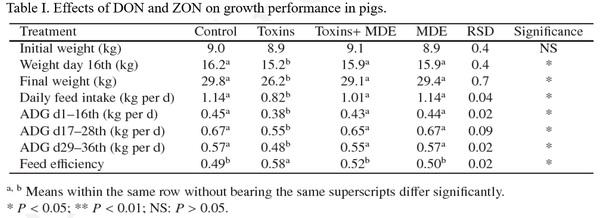
Content sponsored by:
Life Rainbow
Mycotoxin deactivation by mycotoxin degrading enzyme
Published: July 6, 2023
By: Life Rainbow
This study was investigating the effects of a defined concentration of Fusarium mycotoxins, deoxynivalenol (DON) and zearalenone (ZON) incorporated into feeds on growth performance of pigs and the alleviating effects of a mycotoxin degrading enzyme (MDE) on the toxicity of Fusarium mycotoxins.
A total of 48 weaning pigs was randomly allotted to four treatments for a 6-week challenged trial. The MDE product was a kind of mycotoxin degradation enzyme with esterase, epoxidase and peptidase activity.

Growth performance
The results of DON and ZON on growth performance in pigs are summarized in Table I. There were significantly lower (P < 0.05) body weight gains at the 16th day and final day of the experimental period in the Toxins group compared to the other treatments. The results in the growth performance revealed that DON and ZON hampered growth response in pigs as early as the 16th day of the experiment. This could be due to feed refusal behavior caused by DON toxicity. The worst feed efficiency in group Toxins also reflects the toxicity of DON and ZON mycotoxins. The MDE incorporated in the feed with mycotoxins (Toxins+MDE) counteracted the negative effects from mycotoxins, there was no negative effect on growth performance in the MDE alone. Observations on the 7th day of the experiment were obvious vulva swelling seen in female pigs lasting until the end of the experiment in the Toxins group, however, no similar symptoms were observed in the other groups.

Conclusion
The results in different criteria including growth performance showed that DON and ZON consistently impaired pigs after 6-week exposure. Based on these findings, we suggest that the combination of DON and ZON confers a chemical multi-organ toxicity in pigs and MDE provides a partial or complete toxic sparing effect of mycotoxins.
References
Cheng Y.H., C.F. Weng, B.J. Chen, M. H. Chang. 2006. Toxicity of different Fusarium mycotoxins on growth performance, immune responses and efficacy of a mycotoxin degrading enzyme in pigs. Anim Res. 5:579–590.
Related topics:
Authors:
Recommend
Comment
Share
3 de octubre de 2023
Hello Jenny
Nice work. I have a question for you. How about the mycotxins degradation products? Do they are safe for pigs or poultry?
Nice work. I have a question for you. How about the mycotxins degradation products? Do they are safe for pigs or poultry?
Recommend
Reply
Recommend
Reply
29 de septiembre de 2023
Congratulations for the results. I can agree of MDE with partial sparing effect.
Now try the test on real contaminated feed to prove the direct effect on a toxic molecule that is surrounded by flower feed. For now the controled toxins surround the feed, and it is exposed the enzyme. What if the DON ZON are behind?
Now try the test on real contaminated feed to prove the direct effect on a toxic molecule that is surrounded by flower feed. For now the controled toxins surround the feed, and it is exposed the enzyme. What if the DON ZON are behind?
Recommend
Reply
Varsha Group
22 de septiembre de 2023
does enzymes for mycotoxin degradation work in poutry as gut transit time is less?
Recommend
Reply

Would you like to discuss another topic? Create a new post to engage with experts in the community.



